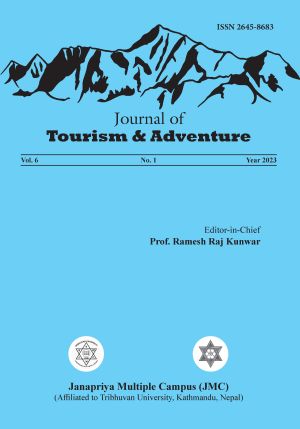Prospect of Tourism Development in Khaptad National Park: A Local Perspective
DOI:
https://doi.org/10.3126/jota.v6i1.58579Keywords:
Prospect of tourism, Khaptad National Park, structural equation modeling, tourist, far-west NepalAbstract
Tourism in Nepal has flourished over the past two decades, making it one of the top global destinations for visit. Its abundant wildlife, stunning trekking routes, snow-fed rivers, picturesque lakes, and warm-hearted locals have been contributing perpetually to appeal to the global and local tourists. With the rise of the digital economy, tourism is experiencing modern advancements. This study aims to analyze the perceptions of local residents regarding tourism development. Structural Equation Modeling (SEM) was employed to validate the research results, utilizing both descriptive and inferential statistics. A sample size of 219 respondents was conveniently selected; indicating a higher interest among males and a predominance of economically active individuals aged 21-40 years. The study shows ICT development emerging as a common challenge for visitors to Khaptad National Park. The SEM results confirmed the fit and validity of five constructs. To establish KNP as a premier tourist destination, the Tourism Board, Government, and Municipality should prioritize its development and manage the influx of tourists. Notably, motivation and subjective norms significantly influence visitors’ behavior, while perceived behavioral control and behavioral intention do not. Local communities should actively engage in promoting tourism through effective marketing strategies, and the improvement of ICT facilities will enhance travel convenience. Hence, efforts should be made to promote local business activities and products. The findings of this analysis will benefit various stakeholders, including the Ministry of Culture, Tourism and Civil Aviation, Nepal Tourism Board, Department of Tourism, hotel associations, Travel agencies, local governments, researchers, professionals, and prospective students. This article is an original work with no potential conflict of interest regarding its research and publication.
Downloads
Downloads
Published
How to Cite
Issue
Section
License
Authors retain the copyright of their articles.




